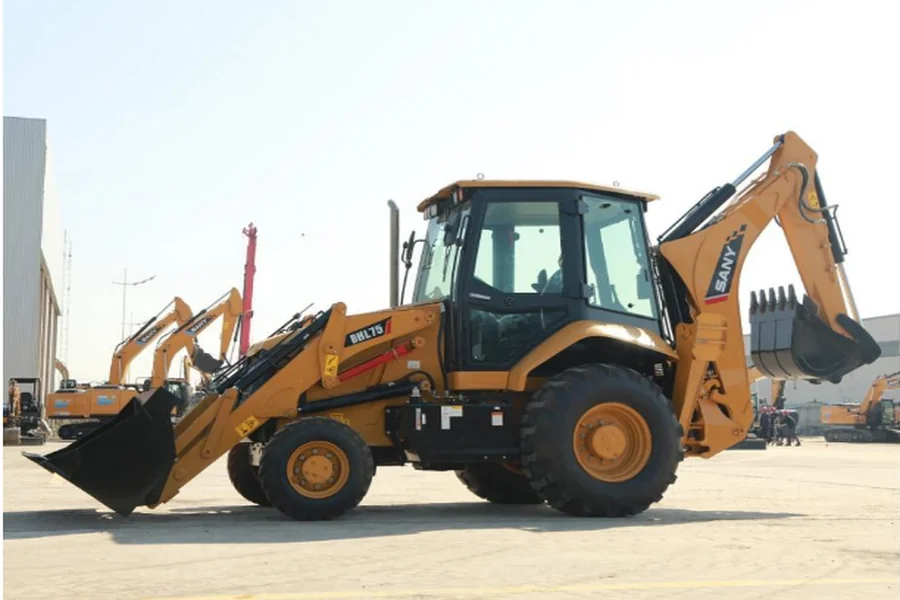Backhoe loaders are essential machines in construction, valued for their versatility and ability to handle various tasks. These powerful machines combine the features of a tractor, a loader, and a backhoe into one cohesive unit. Construction professionals rely on them to perform a range of tasks, from excavation to material handling. Understanding the full capabilities of a backhoe loader can help project managers make informed decisions about equipment needs on site. By leveraging the multifunctionality of backhoe loaders, construction teams can enhance efficiency and productivity, ultimately leading to smoother project execution and significant cost savings.
Key Tasks a Backhoe Loader Can Handle on Site
Backhoe loaders are multifaceted machines capable of performing multiple site tasks with ease.
Digging and Excavation
Backhoe loaders excel at digging and excavation tasks on construction sites. Their powerful hydraulic arm and bucket attachment allow operators to dig trenches, foundations, and ditches quickly and efficiently. The backhoe’s precision is unmatched, enabling it to work in tight spaces where larger excavators might struggle. Operators can easily maneuver the machine to adjust digging depths and angles, ensuring accuracy in every scoop. This adaptability makes backhoe loaders suitable for varying soil conditions, whether it’s loose sand, compact clay, or rocky terrain. By swapping out the backhoe attachment for specialized tools like grapples or augers, crews can expand their operational capabilities even further, enhancing the digging precision and scope of tasks they can handle on-site.
Lifting and Material Handling
Besides digging, backhoe loaders are adept at lifting and material handling, making them indispensable on a busy site. The front loader bucket can transport loose materials such as sand, gravel, and soil across the work area. This reduces the need for additional machinery, saving time and resources. Additionally, the backhoe’s rear boom can be equipped with various attachments such as pallet forks or clamshell buckets to lift and move heavy materials or equipment. This versatility simplifies workflows and minimizes the material handling burden typically faced during construction activities. Operators can quickly switch between tasks, maintaining a seamless workflow and ensuring that materials are precisely placed, reducing the chances of costly errors.
Advantages of Using a Backhoe Loader on Site
Backhoe loaders bring significant benefits that improve construction site operations.
Flexibility and Efficiency
The flexibility of backhoe loaders significantly boosts site efficiency. These machines can adapt to perform a multitude of tasks by simply switching attachments, eliminating downtime between different stages of a project. Whether the site demands digging, loading, breaking, or transporting materials, a backhoe loader is a one-stop solution. This flexibility reduces the need for multiple specialized machines, optimizing the workforce and improving logistical management. Operators can quickly respond to changing site needs, which helps projects stay on track and within deadlines. The all-in-one nature of backhoe loaders enhances site productivity and efficiency, addressing various tasks without unnecessary interruptions or delays.
Cost-Effectiveness
From a financial perspective, backhoe loaders are highly cost-effective. Investing in this multitasking machinery can lead to significant reductions in equipment costs, as one machine can perform the jobs of several different machines. Operating one versatile machine instead of multiple specialized ones saves on fuel, maintenance, and labor. Moreover, the quick adaptability and transition between tasks minimize project downtime, further increasing returns on investment. Contractors can reduce hiring costs for operators, as a single operator can handle diverse activities using a backhoe loader. By optimizing resource allocation, backhoe loaders support a project’s feasibility, ensuring budget goals are met without compromising performance.

Backhoe Loader in Specific Applications
The versatility of backhoe loaders extends to many specific construction applications.
Landscaping and Site Preparation
In landscaping and site preparation, backhoe loaders deliver precision and adaptability. The machines reshape terrain by removing, transporting, and distributing soil and debris, laying a foundation for further construction or landscaping activities. Backhoe loaders can adjust the slope of land, dig out unwanted elements, and provide a leveled area for building or planting. Operators employ the loader for topsoil dispersal, reducing manual labor and enhancing speed. Their adaptability makes them ideal for preparing sites with complex designs, whether for gardens, parks, or structural blueprints, ensuring projects align seamlessly with architectural or landscaping visions.
Utility Work and Pipeline Projects
Backhoe loaders play a crucial role in utility work and pipeline projects. Their compact design and powerful digging capabilities allow precise trenching for utility lines and pipes. These machines efficiently navigate through urban or restricted spaces, making them suitable for street or urban utility work. By handling trenching, lifting pipelines, and backfilling with one machine, teams reduce the number of equipment and personnel on site, streamlining the installation process. Backhoe loaders also facilitate maintenance and repairs, quickly reaching buried utilities without extensive disruption, demonstrating their importance in efficient infrastructure development and continuity.
Conclusion
Backhoe loaders are indispensable assets on construction sites, offering versatility and efficiency essential for modern projects. Their ability to seamlessly switch between digging, lifting, and various other tasks minimizes downtime and maximizes productivity. By reducing the need for multiple machines, backhoe loaders provide significant cost savings while maintaining high performance levels. Their role extends beyond traditional construction to include specialized applications like landscaping and utility work. As project demands evolve, incorporating these machines into site operations ensures that teams can tackle diverse challenges efficiently, effectively embodying the adaptability needed in the dynamic world of construction.





